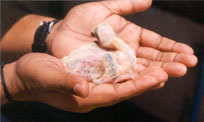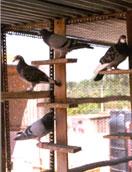On weekdays he takes classes in Communicative English at Christ College, guiding
students through the nuances of Literary Criticism and Journalistic skills. But it is on
Sundays that Edison Thomas sets out to do what he likes best. He rises early and scans the
skies. If it is a clear day, he then carefully straps on a large rectangular cane basket
(Pannier) onto his motorcycle and takes a long drive down the Bellary Road. The pannier
contains his precious cargo. At the 130 kms road sign, he kills his engine, gets off the
bike and opens up the pannier. And out flies his precious cargo. A flock of twelve homing
pigeons. As Edison looks up, the pigeons fall into perfect formation, swerving and
circling above the highway like MIG - 29's, with the morning sun reflecting the colours
off their bodies. And then almost on cue, they fly off into the horizon, |

|
headed straight for their home, which is a loft atop
Edison's house in J.P.Nagar. A distance of 130 Kilometers. Edison checks his watch and
kicks his bike to life. He will head back home after lunch. Later in the day, almost seven
hours later, when he hits home, his pigeons have beaten him to it by over five hours.
Travelling the 130 kms distance in 100 minutes flat. Edison's birds have not let him down,
turning in another great performance. Edison Thomas is a homing pigeon 'Fancier', a term
used in their circles for breeders, and lovers of these extraordinary birds. In an
exclusive tete-a- tete with Online Bangalore, Edison shares his passion, training
techniques and love for his feathered friends. On the day we met up with him, the skies
are a brilliant clear blue. "A perfect Pigeon Day! he says, fondling his price bird
'Texan', as he excitedly awaits the arrival of his team of four birds who have taken off
from Maharashtra, almost 900 kms away that morning
|
|

|
When did you start rearing and breeding homing
pigeons?
Though I have had pigeons since I was seven years old, my tryst with homing
pigeons came much later. During late 1996. While I was working as a sub-editor with the
Times of India, and while browsing the net during routine work I came across two stories
of homing pigeons. One about diamond smuggling in South African mines and another of
homing pigeons being used to transport marijuana to prison inmates in a Colombian jail.
That set me off on their trail, and picked up my first batch from a breeder in
Tirunelveli.
How do homing pigeons find their way back? |
It’s a combination of nature
and nurture. Nature is their instinct. Though there are many theories, the most accepted
ones are the Magnetic Orientation and Biological Clock theories. Homing pigeons
instinctively have a magnetic orientation and hence they can sense the polarity. So, even
without any training, in a single spin, they can sense and home in. Their in built
biological clock helps them lock in on the sun's position and they navigate keeping the
sun on their left. And nurturing is a combination of right feeding and training
techniques. |
Are they a specific breed?
Most racing pigeons are derivatives of the wild pigeon and the Blue Rock pigeon. Most are
now named after their breeders. Like the American Sions, Stassarets and the Canadian
Janssers (named after the Jansser brothers of Canada). In India the best local breeds are
from Kolkota and Tirunelveli in Southern Tamil Nadu.
What is their lifespan and prime age for racing?
They live upto the age of 25 to 30 years. Though their prime racing years are
between 11/2 to 51/2 years, We start 'Basket training' them when they are about 41/2
months old, and by the time they are 7 months they are racing away and ready to mate when
back home after the flight.
How do you train them? |

|
|